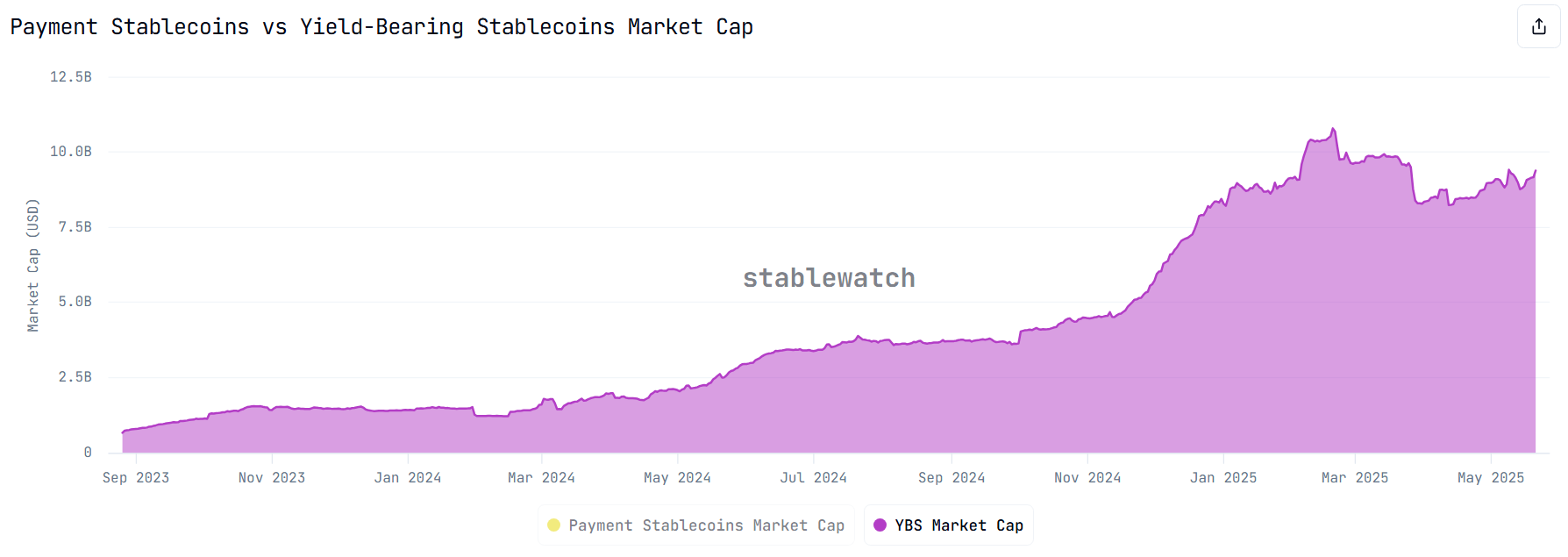Yield-Bearing Stablecoins Explode 13x in 24 Months—Traders Chase Yield While Banks Scramble
Once a niche corner of DeFi, yield-bearing stablecoins now dominate crypto’s risk-off plays. Here’s how they went from backwater to big leagues.
The Quiet Revolution
No flashy memecoins here—just cold, hard yield. While regulators obsessed over unbacked crypto, these dollar-pegged assets quietly built a $50B+ empire.
Why Traders Care
Forget 0.01% savings accounts. Protocols now offer 5-15% APY on stable holdings—turning ’safe’ assets into cashflow machines. (Wall Street’s response? A patented mix of dismissal and trademark lawsuits.)
The Cynic’s Take
Of course banks hate this. Their 1970s-era infrastructure can’t compete with code that settles in seconds and pays real yield—not ’relationship manager’ platitudes.
One thing’s clear: When money talks, the market listens. Even if that money is... technically a spreadsheet entry.
Yield Stablecoin Market Cap Surpasses $10 Billion in 2025
Yield-bearing stablecoins differ from traditional stablecoins in that they not only maintain a stable value but also generate returns for holders. These returns come from investment strategies like staking, lending, or investing in yield-generating assets such as government bonds.
According to data from Stablewatch, the total supply of yield-bearing stablecoins has grown 13 times in under two years, from just $666 million in August 2023 to $8.98 billion in May 2025. At one point, in February 2025, the market hit an all-time high of $10.8 billion.

Stablewatch also reports that the total accumulated yield paid out has reached nearly $600 million. The current average payout stands at around $1.5 million per day.
Among the most notable projects, Ethena’s sUSDe and Sky’s sUSDS and sDAI are leading the market. Together, these projects account for 57% of the total yield stablecoin market capitalization — about $5.13 billion.
Data from DeFiLlama shows that the market now includes over 1,900 stablecoin pools, spread across 465 protocols and more than 100 different chains. These pools allow investors to deposit stablecoins and earn yield.
Despite impressive growth, Jacek Czarnecki, co-founder of L2Beat, points out that yield-bearing stablecoins still make up only a small portion of the broader stablecoin market. At the time of writing, the total stablecoin market cap has reached over $244 billion.
“Yield-first stablecoins are still just a small fraction (3.7%) of the general stablecoin market,” Jacek said.
Still, this small share also reflects the enormous growth potential of yield-stablecoins. More investors are now looking for passive income opportunities in the DeFi space.
Challenges Facing the Yield Stablecoin Sector
According to Jacek Czarnecki, yield-bearing stablecoins still have no standardized definition. This lack of clarity makes it difficult to categorize and evaluate these assets.
Jacek classifies stablecoins into two groups: payments vs. yield. While simple, this distinction could help shape dedicated legal frameworks for each type.
“Stablecoins are widely seen as crypto’s breakout use case. But to scale, we need a more user-centric framework. You shouldn’t buy coffee with your yield vault. Combining both types in one category (as many dashboards do) is like storing your paycheck in a hedge fund: technically possible, but it doesn’t make too much sense,” Jacek explained.
Lawmakers are beginning to acknowledge this division. For instance, the GENIUS Act in the US specifies that stablecoins offering yields or interest do not qualify as “payment stablecoins.”
This means these stablecoins fall outside the bill’s regulatory scope. They may instead be classified as securities, subject to oversight by the US Securities and Exchange Commission (SEC).
Meanwhile, the MiCA (Markets in Crypto-Assets Regulation) in the European Union prohibits interest payments on stablecoins altogether. Because of this regulatory ambiguity and legal limitations, the yield stablecoin market may not be booming yet. So far, it has mainly attracted attention from insiders and early investors.
However, the involvement of major financial institutions in the stablecoin sector gives reason to expect a more flexible stance from lawmakers. To maintain momentum and ensure sustainability, projects must address key regulations, transparency, and risk management challenges.

